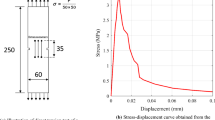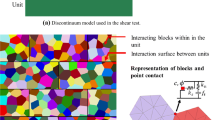Abstract
This study explores the effect of the local fracture mechanisms of unreinforced masonry (URM) walls on their macro-behavior through different contact models implemented within the discrete element method (DEM). The brittle contact constitutive laws are the standard choice for simulating block interaction in the literature when the discontinuum-based analysis of masonry structures is performed using DEM. However, this assumption may yield inaccurate predictions related to the pre- and post-peak behavior of brick or stonework assemblages subjected to combined compression–shear loading. To this end, tension–shear and shear–compression coupled elasto-softening contact models are proposed to simulate crack propagation and collapse mechanism phenomena in masonry structures, providing a more accurate prediction of the force–displacement response of URM walls. Throughout the study, the discontinuous nature of masonry composite is modeled via discrete blocks that can interact with each other along their boundaries based on the point contact hypothesis. Once the adopted modeling strategy is validated, its performance is demonstrated by comparing it against the commonly used brittle contact model and other available computational approaches. A comprehensive sensitivity analysis is performed on various essential parameters characterizing the post-peak behavior of contact models, and significant inferences are made. Finally, the proposed contact models have shown to be better alternatives to existing brittle and uncoupled elasto-softening contact models used for the DEM-based simulation of masonry structures.















Similar content being viewed by others
References
Lourenço PB (1996) Computational strategies for masonry structures. Delft University of Technology
Saloustros S, Pelà L, Roca P, Portal J (2015) Numerical analysis of structural damage in the church of the Poblet Monastery. Eng Fail Anal 48:41–61. https://doi.org/10.1016/j.engfailanal.2014.10.015
Lourenço PB, Rots JG, Blaauwendraad J (1998) Continuum model for masonry: Parameter estimation and validation. J Struct Eng 124:642–652. https://doi.org/10.1061/(ASCE)0733-9445(1998)124:6(642)
Pelà L, Cervera M, Roca P (2013) An orthotropic damage model for the analysis of masonry structures. Constr Build Mater 41:957–967. https://doi.org/10.1016/j.conbuildmat.2012.07.014
Funari MF, Spadea S, Lonetti P et al (2020) Visual programming for structural assessment of out-of-plane mechanisms in historic masonry structures. J Build Eng 31:101425. https://doi.org/10.1016/j.jobe.2020.101425
Gonen S, Soyoz S (2021) Investigations on the elasticity modulus of stone masonry. Structures 30:378–389. https://doi.org/10.1016/j.istruc.2021.01.035
Pulatsu B, Erdogmus E, Lourenço PB et al (2020) Discontinuum analysis of the fracture mechanism in masonry prisms and wallettes via discrete element method. Meccanica 55:505–523. https://doi.org/10.1007/s11012-020-01133-1
Sarhosis V, Lemos JV (2018) A detailed micro-modelling approach for the structural analysis of masonry assemblages. Comput Struct 206:66–81. https://doi.org/10.1016/j.compstruc.2018.06.003
Zhang S, Beyer K (2019) Numerical investigation of the role of masonry typology on shear strength. Eng Struct 192:86–102. https://doi.org/10.1016/j.engstruct.2019.04.026
Zhang S, Taheri Mousavi SM, Richart N et al (2017) Micro-mechanical finite element modeling of diagonal compression test for historical stone masonry structure. Int J Solids Struct 112:122–132. https://doi.org/10.1016/j.ijsolstr.2017.02.014
Kesavan P, Menon A (2022) Investigation of in-plane and out-of-plane interaction in unreinforced masonry piers by block-based micro-modeling. Structures 46:1327–1344. https://doi.org/10.1016/j.istruc.2022.10.105
Lourenço PB, Rots JG (1997) Multisurface interface model for analysis of masonry structures. J Eng Mech 123:660–668
Pulatsu B, Bretas EM, Lourenço PB (2016) Discrete element modeling of masonry structures: validation and application. Earthquakes Struct 11:563–582. https://doi.org/10.12989/eas.2016.11.4.563
Li Y, Zeng B (2023) Modeling of masonry structures using a new 3D cohesive interface material model considering dilatancy softening. Eng Struct 277:115466. https://doi.org/10.1016/j.engstruct.2022.115466
Patel KP, Dubey RN (2022) Effect of flanges on the in-plane behavior of the masonry walls. Eng Struct 273:115059. https://doi.org/10.1016/j.engstruct.2022.115059
Howlader MK, Masia MJ, Griffith MC (2020) Numerical analysis and parametric study of unreinforced masonry walls with arch openings under lateral in-plane loading. Eng Struct 208:110337. https://doi.org/10.1016/j.engstruct.2020.110337
Shrestha JK, Pradhan S, Gautam D (2020) In-plane behavior of various brick bonds in masonry walls. Innov Infrastruct Solut 5:1–10. https://doi.org/10.1007/s41062-020-00306-x
D’Altri AM, Messali F, Rots JG et al (2019) A damaging block-based model for the analysis of the cyclic behaviour of full-scale masonry structures. Eng Fract Mech 209:423–448. https://doi.org/10.1016/j.engfracmech.2018.11.046
Lemos JV (1997) Discrete element modeling of the seismic behavior of stone masonry arches. In: Pande GN, Middleton J, Kralj B (eds) Computer methods in structural masonry. E&FN Spon, Florence, pp 220–227
Psycharis I, Lemos JV, Papastamatiou DY et al (2003) Numerical study of the seismic behaviour of a part of the Parthenon Pronaos. Earthq Eng Struct Dyn 32:2063–2084. https://doi.org/10.1002/eqe.315
Jiang K, Esaki T (2002) Quantitative evaluation of stability changes in historical stone bridges in Kagoshima, Japan, by weathering. Eng Geol 63:83–91. https://doi.org/10.1016/S0013-7952(01)00071-0
Ravi Prakash P, Pulatsu B, Lourenço PB et al (2020) A meso-scale discrete element method framework to simulate thermo-mechanical failure of concrete subjected to elevated temperatures. Eng Fract Mech 239:107269. https://doi.org/10.1016/j.engfracmech.2020.107269
Ghazvinian E, Diederichs MS, Quey R (2014) 3D random Voronoi grain-based models for simulation of brittle rock damage and fabric-guided micro-fracturing. J Rock Mech Geotech Eng 6:506–521. https://doi.org/10.1016/j.jrmge.2014.09.001
Pulatsu B, Erdogmus E, Lourenço PB, Quey R (2019) Simulation of uniaxial tensile behavior of quasi-brittle materials using softening contact models in DEM. Int J Fract 217:105–125. https://doi.org/10.1007/s10704-019-00373-x
Kazerani T (2013) A discontinuum-based model to simulate compressive and tensile failure in sedimentary rock. J Rock Mech Geotech Eng 5:378–388. https://doi.org/10.1016/j.jrmge.2013.07.002
Oñate E, Zárate F, Miquel J et al (2015) A local constitutive model for the discrete element method. Application to geomaterials and concrete. Comput Part Mech 2:139–160. https://doi.org/10.1007/s40571-015-0044-9
Ferrante A, Loverdos D, Clementi F et al (2021) Discontinuous approaches for nonlinear dynamic analyses of an ancient masonry tower. Eng Struct 230:111626. https://doi.org/10.1016/j.engstruct.2020.111626
Gonen S, Pulatsu B, Erdogmus E et al (2021) Quasi-static nonlinear seismic assessment of a fourth century A.D. Roman Aqueduct in Istanbul, Turkey. Heritage 4:401–421. https://doi.org/10.3390/heritage4010025
Cundall PA (1988) Formulation of a three-dimensional distinct element model—Part I. A scheme to detect and represent contacts in a system composed of many polyhedral blocks. Int J Rock Mech Min Sci Geomech 25:107–116
Hart R, Cundall PA, Lemos JV (1988) Formulation of a three-dimensional distinct element model—Part II. Mechanical calculations for motion. Int J Rock Mech Min Sci Geomech 25:117–125
Cundall PA, Detournay C (2017) Dynamic relaxation applied to continuum and discontinuum numerical models in geomechanics. Rock mechanics and engineering. CRC Press, pp 57–102
Itasca Consulting Group Inc. (2013) 3DEC three dimensional distinct element code
Lemos JV (2008) Block modelling of rock masses. Concepts and application to dam foundations. Rev Eur génie Civ 12:915–949. https://doi.org/10.3166/ejece.12.915-949
Godio M, Stefanou I, Sab K (2018) Effects of the dilatancy of joints and of the size of the building blocks on the mechanical behavior of masonry structures. Meccanica 53:1629–1643. https://doi.org/10.1007/s11012-017-0688-z
Pulatsu B, Gonen S, Lourenço PB et al (2022) Computational investigations on the combined shear–torsion–bending behavior of dry-joint masonry using DEM. Comput Part Mech. https://doi.org/10.1007/s40571-022-00493-7
Liu Z, Crewe A (2020) Effects of size and position of openings on in - plane capacity of unreinforced masonry walls. Bull Earthq Eng. https://doi.org/10.1007/s10518-020-00894-0
Bui TT, Limam A, Sarhosis V (2019) Failure analysis of masonry wall panels subjected to in-plane and out-of-plane loading using the discrete element method. Eur J Environ Civ Eng. https://doi.org/10.1080/19648189.2018.1552897
Giordano A, Mele E, De Luca A (2002) Modelling of historical masonry structures: comparison of different approaches through a case study. Eng Struct 24:1057–1069. https://doi.org/10.1016/S0141-0296(02)00033-0
Cuong NH, Shin J, Kim JH et al (2022) Compressive and shear behavior of brick masonry assemblages strengthened with polyurea coating: Experiment and DEM investigations. Constr Build Mater 348:128534. https://doi.org/10.1016/j.conbuildmat.2022.128534
Gonen S, Pulatsu B, Lourenço PB et al (2023) Analysis and prediction of masonry wallette strength under combined compression-bending via stochastic computational modeling. Eng Struct 278:115492. https://doi.org/10.1016/j.engstruct.2022.115492
Pulatsu B, Erdogmus E, Lourenço PB et al (2020) Simulation of the in-plane structural behavior of unreinforced masonry walls and buildings using DEM. Structures 27:2274–2287. https://doi.org/10.1016/j.istruc.2020.08.026
Lemos JV, Sarhosis V (2022) Discrete Element Bonded-Block Models for Detailed Analysis of Masonry. Infrastructures 7:31. https://doi.org/10.3390/infrastructures7030031
Resende R, Lemos J V., Dinis PB (2004) Application of a discontinuity model with softening to the analysis of dam foundations using the Discrete Element Method. In: 1st international UDEC/3DEC symposium: numerical modelling of discrete materials in geotechnical engineering, civil engineering and earth sciences, pp 249–255
Vermeltfoort AT, Raijmakars TMJ, Janssen HJM (1993) Shear tests on masonry walls. In: Proceedings 6th North American masonry conference, Philadelphia. Philadelphia, pp 1183–1193
Kumar N, Amirtham R, Pandey M (2014) Plasticity based approach for failure modelling of unreinforced masonry. Eng Struct 80:40–52. https://doi.org/10.1016/j.engstruct.2014.08.021
Nie Y, Sheikh A, Visintin P, Griffith M (2022) An interfacial damage-plastic model for the simulation of masonry structures under monotonic and cyclic loadings. Eng Fract Mech 271:108645. https://doi.org/10.1016/j.engfracmech.2022.108645
Chaimoon K, Attard MM (2007) Modeling of unreinforced masonry walls under shear and compression. Eng Struct 29:2056–2068. https://doi.org/10.1016/j.engstruct.2006.10.019
Lourenço PB, Gaetani A (2022) Recommended properties for advanced numerical analysis. In: Finite element analysis for building assessment advanced use and practical recommendations. Routledge, pp 209–321
Kumar N, Barbato M, Rengifo-López EL, Matta F (2022) Capabilities and limitations of existing finite element simplified micro-modeling techniques for unreinforced masonry. Res Eng Struct Mater 8:463–490. https://doi.org/10.17515/resm2022.408st0226
Author information
Authors and Affiliations
Corresponding author
Ethics declarations
Conflict of interest
The author declare that they have no conflict of interest.
Additional information
Publisher's Note
Springer Nature remains neutral with regard to jurisdictional claims in published maps and institutional affiliations.
Rights and permissions
Springer Nature or its licensor (e.g. a society or other partner) holds exclusive rights to this article under a publishing agreement with the author(s) or other rightsholder(s); author self-archiving of the accepted manuscript version of this article is solely governed by the terms of such publishing agreement and applicable law.
About this article
Cite this article
Pulatsu, B. Coupled elasto-softening contact models in DEM to predict the in-plane response of masonry walls. Comp. Part. Mech. 10, 1759–1770 (2023). https://doi.org/10.1007/s40571-023-00586-x
Received:
Revised:
Accepted:
Published:
Issue Date:
DOI: https://doi.org/10.1007/s40571-023-00586-x




